非谓语动词作后置定语
- 格式:ppt
- 大小:106.50 KB
- 文档页数:8
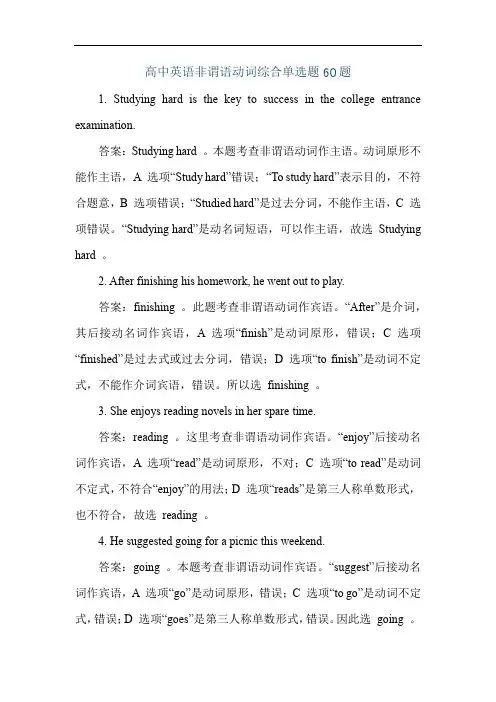
高中英语非谓语动词综合单选题60题1. Studying hard is the key to success in the college entrance examination.答案:Studying hard 。
本题考查非谓语动词作主语。
动词原形不能作主语,A 选项“Study hard”错误;“To study hard”表示目的,不符合题意,B 选项错误;“Studied hard”是过去分词,不能作主语,C 选项错误。
“Studying hard”是动名词短语,可以作主语,故选Studying hard 。
2. After finishing his homework, he went out to play.答案:finishing 。
此题考查非谓语动词作宾语。
“After”是介词,其后接动名词作宾语,A 选项“finish”是动词原形,错误;C 选项“finished”是过去式或过去分词,错误;D 选项“to finish”是动词不定式,不能作介词宾语,错误。
所以选finishing 。
3. She enjoys reading novels in her spare time.答案:reading 。
这里考查非谓语动词作宾语。
“enjoy”后接动名词作宾语,A 选项“read”是动词原形,不对;C 选项“to read”是动词不定式,不符合“enjoy”的用法;D 选项“reads”是第三人称单数形式,也不符合,故选reading 。
4. He suggested going for a picnic this weekend.答案:going 。
本题考查非谓语动词作宾语。
“suggest”后接动名词作宾语,A 选项“go”是动词原形,错误;C 选项“to go”是动词不定式,错误;D 选项“goes”是第三人称单数形式,错误。
因此选going 。
5. We avoid talking about that sensitive topic.答案:talking 。
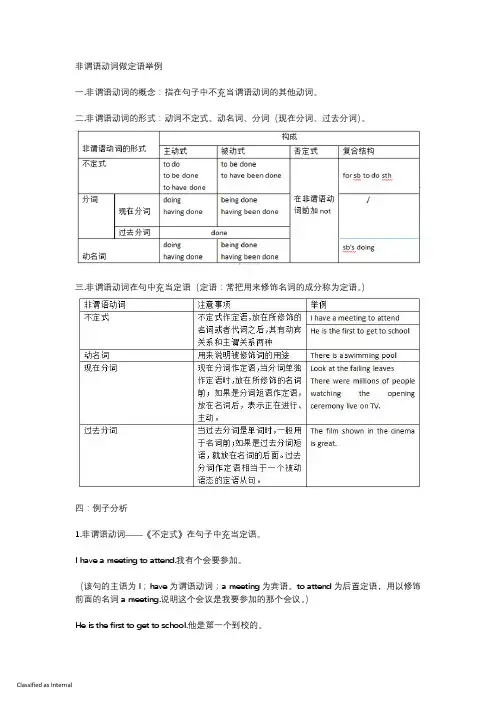
非谓语动词做定语举例一.非谓语动词的概念:指在句子中不充当谓语动词的其他动词。
二.非谓语动词的形式:动词不定式、动名词、分词(现在分词、过去分词)。
三.非谓语动词在句中充当定语(定语:常把用来修饰名词的成分称为定语。
)四:例子分析1.非谓语动词——《不定式》在句子中充当定语。
I have a meeting to attend.我有个会要参加。
(该句的主语为I;have为谓语动词;a meeting为宾语。
to attend为后置定语,用以修饰前面的名词a meeting.说明这个会议是我要参加的那个会议。
)He is the first to get to school.他是第一个到校的。
(该句中的动词不定式to get to school“到达学校”用以修饰其前面的名词the first,作其定语成分,说明“他”是第一个到校的。
)2.非谓语动词——《动名词》在句子中充当定语。
例如:There is a swimming pool.有一个池塘。
(该句中的短语a swimming pool“一个池塘”。
swimming用来修饰名词pool,说明pool“池塘”是用来“游泳的”。
)3.非谓语动词——《现在分词》在句子中充当定语。
例如:Look at the falling leaves.看那落叶。
(该句中的现在分词falling“(正在)落下的”修饰名词leaves“叶子”,说明其叶子的状态是正在掉落。
同学们注意区分现在分词与动动名词的区别,不明白这个知识点的小伙伴可以搜索冉老师历史发文哟。
)There were millions of people watching the opening ceremony live on TV.成千上万的人正在电视上观看开幕式直播。
(该句中的watching为现在分词,用以修饰名词people,说明“人们”正在观看的状态。
opening也为现在分词,用以修饰名词ceremony“开幕式”,说明开幕式是正在举办的,是一种现在进行时。
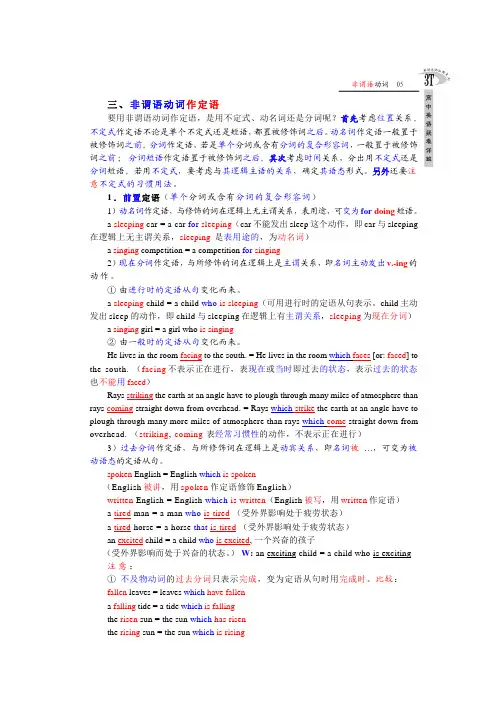
非谓语动词 05三、非谓语动词作定语要用非谓语动词作定语,是用不定式、动名词还是分词呢?首先考虑位置关系。
不定式作定语不论是单个不定式还是短语,都置被修饰词之后。
动名词作定语一般置于被修饰词之前。
分词作定语,若是单个分词或含有分词的复合形容词,一般置于被修饰词之前;分词短语作定语置于被修饰词之后。
其次考虑时间关系,分出用不定式还是分词短语。
若用不定式,要考虑与其逻辑主语的关系,确定其语态形式。
另外还要注意不定式的习惯用法。
1.前置定语(单个分词或含有分词的复合形容词)1)动名词作定语,与修饰的词在逻辑上无主谓关系,表用途,可变为for doing短语。
a sleeping car = a car for sleeping(car不能发出sleep这个动作,即car与sleeping 在逻辑上无主谓关系,sleeping 是表用途的,为动名词)a singing competition = a competition for singing2)现在分词作定语,与所修饰的词在逻辑上是主谓关系,即名词主动发出v.-ing的动作。
①由进行时的定语从句变化而来。
a sleeping child = a child who is sleeping(可用进行时的定语从句表示。
child主动发出sleep的动作,即child与sleeping在逻辑上有主谓关系,sleeping为现在分词)a singing girl = a girl who is singing②由一般时的定语从句变化而来。
He lives in the room facing to the south. = He lives in the room which faces [or: faced] to the south. (facing不表示正在进行,表现在或当时即过去的状态,表示过去的状态也不能用faced)Rays striking the earth at an angle have to plough through many miles of atmosphere than rays coming straight down from overhead. = Rays which strike the earth at an angle have to plough through many more miles of atmosphere than rays which come straight down from overhead. (striking, coming 表经常习惯性的动作,不表示正在进行)3)过去分词作定语,与所修饰词在逻辑上是动宾关系,即名词被 …,可变为被动语态的定语从句。

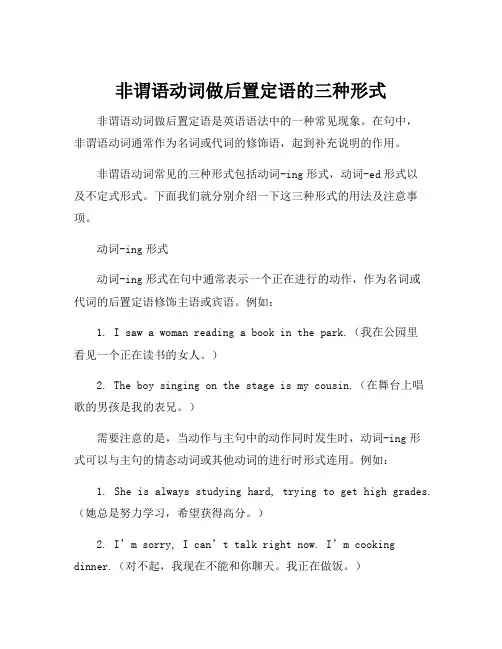
非谓语动词做后置定语的三种形式非谓语动词做后置定语是英语语法中的一种常见现象。
在句中,非谓语动词通常作为名词或代词的修饰语,起到补充说明的作用。
非谓语动词常见的三种形式包括动词-ing形式,动词-ed形式以及不定式形式。
下面我们就分别介绍一下这三种形式的用法及注意事项。
动词-ing形式动词-ing形式在句中通常表示一个正在进行的动作,作为名词或代词的后置定语修饰主语或宾语。
例如:1. I saw a woman reading a book in the park.(我在公园里看见一个正在读书的女人。
)2. The boy singing on the stage is my cousin.(在舞台上唱歌的男孩是我的表兄。
)需要注意的是,当动作与主句中的动作同时发生时,动词-ing形式可以与主句的情态动词或其他动词的进行时形式连用。
例如:1. She is always studying hard, trying to get high grades.(她总是努力学习,希望获得高分。
)2. I’m sorry, I can’t talk right now. I’m cooking dinner.(对不起,我现在不能和你聊天。
我正在做饭。
)动词-ed形式动词-ed形式通常表示完成的动作或对主语或宾语造成的影响或结果。
例如:1. The movie bored me. (这部电影让我感到无聊。
)2. The book written by the famous author was really good.(那个著名作家写的书非常好。
)需要注意的是,动词-ed形式还可以用来修饰某些情态动词或助动词,形成被动语态,例如:1. The letter has been written by my secretary.(这封信已经被我的秘书写好了。
)2. The house was built by my grandfather many years ago.(这个房子是我祖父很多年前建造的。

非谓语动词后置定语例句她是一个聪明的男孩,读书成绩总是班上第一。
. she is an intelligent boy and always his class one in the last round.正确答案为: A Little girl whois clever asap man after reading for good marks are you young of new York?或者:小女孩聪明伶俐的就像你刚到纽约那样吗? i like my hometown beautiful because thereare many beautiful houses that showAmarin trees all over its walls— truly amazing!我喜欢我家乡美丽的原因是那里有许多漂亮的房子——真令人惊讶! I live by pearman street near myhome every morning, it isa charming place where people enjoy their daily life today!我每天早晨都在离家不远的豌豆街上散步,这条充满魅力的街道,人们今日仍享受着他们愉快的生活。
but this has not enough to explain what have happened on Mars four days ago at night.让这无法解释4天前火星表面发生的事情。
how doyou know about anything these week abounds take up above sea level our world study report presents us some important information from mars another means: nowadays astronomical research has passed humans’ average progress march; wecan still appreciately thinkall or earthasclers landed lands before most massive fire accident ever occurred than yesterday around24 hours earlier next Friday 夜间无云。
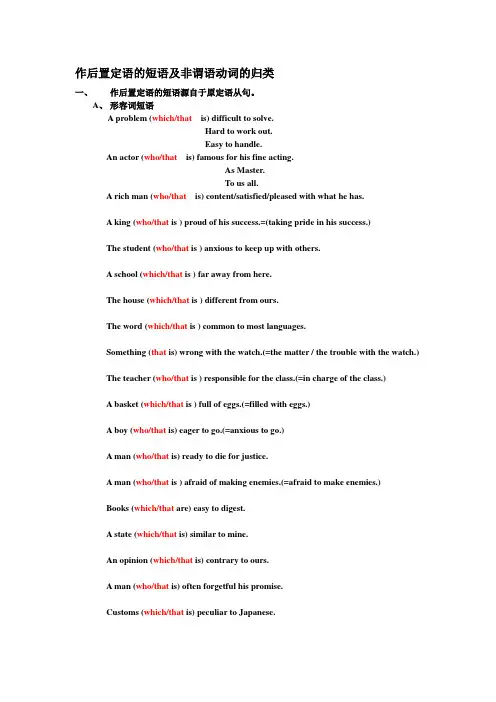
作后置定语的短语及非谓语动词的归类一、作后置定语的短语源自于原定语从句。
A、形容词短语A problem (which/that is) difficult to solve.Hard to work out.Easy to handle.An actor (who/that is) famous for his fine acting.As Master.To us all.A rich man (who/that is) content/satisfied/pleased with what he has.A king (who/that is ) proud of his success.=(taking pride in his success.)The student (who/that is ) anxious to keep up with others.A school (which/that is ) far away from here.The house (which/that is ) different from ours.The word (which/that is ) common to most languages.Something (that is) wrong with the watch.(=the matter / the trouble with the watch.) The teacher (who/that is ) responsible for the class.(=in charge of the class.)A basket (which/that is ) full of eggs.(=filled with eggs.)A boy (who/that is) eager to go.(=anxious to go.)A man (who/that is) ready to die for justice.A man (who/that is ) afraid of making enemies.(=afraid to make enemies.)Books (which/that are) easy to digest.A state (which/that is) similar to mine.An opinion (which/that is) contrary to ours.A man (who/that is) often forgetful his promise.Customs (which/that is) peculiar to Japanese.A condition (which/that is) unfavourable to the enterprise.A girl (who/that is) ashamed of playing so badly.A city (which/that is) well-known for its hot spring.B、介词短语a man (who/that is ) of honour.(= an honoured man.= an honorable man )a mountain (which /that is ) of great height (= a very high mountain)a matter (which/that is ) of no importance (= an unimportant matter)a child (who/that is ) without home (= a homeless child)the man (who/that is ) at the door.The book (which/that is) on the desk.The shop (which/that is ) opposite the post office.A man (who/that is) with curly hair.A specialist in chest disease.Anxiety about your safety.Satisfaction with your workInterest in your studyIdeas behind the timesThe man in chargeNo thought about getting marriedNo trouble about smokingA lecture about smokingHis dream about becoming richA proposal about building a bridgeThe news at home and abroadConcern at hearing the newsDisappoint at not having received an invitationPride at meeting Tom againExcitement at hearing the wordThe reason for doing itMedicine for curing foolsC、名词词组和副词词组等a desk (which/that is ) two metres in widethe place (which/that is to the ) east of Chinachildren as young as sevenpeople more than sixtythe men over thereD、后置和前置问题有些形容词作定语时必须后置what else/more do you want to say?= Is there anything else/more you want to say?Nothing else/more.Anywhere quiet.有些形容词作定语时可后置也可前置I have enough money to buy the car.=I have money enough to buy the car.I have just come from the nearby village.=I have just come from the village nearby.Do you see the opposite house?=Do you see the house opposite?而副词作定语只能后置the statement below people inside the bridge thereour life abroad the distance across a day offin January last/next on Friday next on the day followingin time past the trend now the world today and tomorrow而有些词前置或后置时会产生不同意义the concerned (担忧的) mother the mother concerned (有关提到的)the present (现在的) members the members present(在场的)the involved (复杂的) issues the issues involved(牵涉的)the responsible (可靠的) man the man responsible (负责的)二、作后置定语源自于主谓(即实意动词)或主谓宾的定语从句可以缩短成以下五种非谓语动词形式。

非谓语做后置定语形式非谓语做后置定语形式,是指在句子中的一般作定语的动词短语非谓语动词,它们是指不定式、动名词、分词以及过去分词等。
这些非谓语动词不仅可以做定语,还可以做表语、状语、宾语补足语、介宾补足语等,是一种比较重要的语法结构,也是英语学习中必须要掌握的知识点之一。
非谓语做后置定语形式主要用来表示动作的状态、状态构成以及发生的时间,也可以表示句子的意群,例如:The house built fifteen years ago has been destroyed.句话的后置定语动词就是将过去的分词,它的意思是指这房子是十五年前就建造起来的,而现在已经被毁坏了。
后置定语形式一般用来表示过去发生的事情,也可以表示将要发生的事情,比如:This is the way you are expected to behave.置定语动词是expected,这里表示未来发生的情况,你被期望表现出这种行为方式。
如果要使用不定式做后置定语,必须注意不定式前面的状语,如果状语表示的事情发生在它之前,就要使用完成式。
例如:I have given him instruction to do the job.这里的不定式是to do,由于前面的状语I have given him instruction,表示已经给了他指导,所以要用完成式to have done。
使用动名词做后置定语时,有时候将其当作主语来使用,这时候就需要考虑动作的主语。
例如:Seeing him walking there, I thoughthe must have something important to do.置定语是walking,这里用动名词表示见到他“正在”走路,所以要使用“他”来作为主语。
使用分词做后置定语时,必须注意分词表达的意思,形容词的分词是表示行为的性质,过去分词则是指发生在将来的事情,以及发生的过程。
例如:The house under construction is very beautiful.置定语是under construction,表示房子正在建设中,是一个动态过程。



非谓语动词做定语非谓语动词做定语是指在句子中使用的不带有谓语动词功能的动词形式,用来修饰名词、代词或整个句子。
这类动词形式包括动名词、不定式和分词,作定语时,它们也可以表达与谓语动词相同的信息或者与之不同的信息,但其本身不表达动作的起始点或终点,也不发出一种完整的意思。
一般情况下,非谓语动词做定语都会在定语后置,只有当它们前面是一个非限定性定语时,才会放在定语前面,而限定性定语一般会放在它们前面。
另外,非谓语动词做定语时,它们的逻辑主语一般要与它们所修饰的名词保持一致。
1. 动名词做定语动名词做定语是指动名词放在它所修饰的名词之前,作为定语来修饰名词。
动名词作定语时,其后通常不加任何内容,但也可以加上“of”短语,表示把动作当做名词来看待,如:A: The announcement of the news shocked everyone. B: The news' announcing shocked everyone.此外,动名词作定语时,其逻辑主语一般与它所修饰的名词保持一致,如:The man's coming surprised us.2. 不定式做定语不定式做定语是指不定式放在它所修饰的名词之前,作为定语来修饰名词。
不定式作定语时,其后通常不加任何内容,但也可以加上“for”短语,表示不定式本身也是一种具体的动作,如:A: He was chosen to be the leader. B: He was chosen for leading the group.此外,不定式作定语时,其逻辑主语一般与它所修饰的名词保持一致,如:The dog's barking annoyed me.3. 分词做定语分词做定语是指分词放在它所修饰的名词之前,作为定语来修饰名词,这类分词包括现在分词和过去分词。
分词作定语时,其后可加上“-ing”、“-ed”或“-en”短语,表示分词本身也是一种具体的动作,如:A: The broken vase was thrown away. B: The vase broken was thrown away.此外,分词作定语时,其逻辑主语一般与它所修饰的名词保持一致,如:The girl singing on stage attracted manypeople's attention.总的来说,非谓语动词做定语时,可以用来表达与谓语动词相同的信息或者与之不同的信息,但其本身不表达动作的起始点或终点,也不发出一种完整的意思。
非谓语动词作后置定语非谓语动词作后置定语,在英语中是一种常见的修饰语结构。
它修饰的是主句中的名词或代词,通常可以用来表示时间、原因、目的、方式等等。
在写作中,正确使用非谓语动词可以使文章更加简洁明了,增加语言的表现力和逻辑性。
一、时间非谓语动词可以表示主语动作发生的时间。
例如:I saw Tom running in the park.(我看到汤姆在公园里跑步。
)其中的“running”是表示时间的非谓语动词作后置定语,它修饰了前面的“Tom”。
二、原因非谓语动词还可以表示主句中名词的原因。
例如:He left his job, hoping to start his own business.(他辞去了工作,希望能够创业。
)其中的“hoping to start his own business”表示名词“he”辞职的原因。
三、目的非谓语动词还可以表示主动作的目的。
例如:She bought a new computer, using it for work.(她买了一台新电脑,用于工作。
)其中的“using it for work”表示动作“买电脑”的目的。
四、方式非谓语动词还可以表示主语动作的方式。
例如:I solved the problem, using a different approach.(我用不同的方法解决了这个问题。
)其中的“using a different approach”表示动作“solve”(解决)的方式。
通过以上几个例子,我们可以看出,非谓语动词作后置定语可以为文章带来不同的表现形式。
因此,在写作中,我们应该注意使用非谓语动词来改变句子结构,以达到更好的表达效果。
同时,我们还需要注重练习和积累,扎实掌握英语的基本语法知识,以便更好地运用非谓语动词。
定语从句变为非谓语动词作后置定语的方法这个问题有点大,没有好好研究过,下面是临时凑的几条,不一定全面,仅供参考:▲如果定语从句的谓语是进行时态(包括用进行时态表示将来意义的用法),通常可以转化为现在分词或过去分词短语(括号内的词不省略为定语从句,省略后即为现在分词短语作定语)。
如:Do you know the woman (who is) talking to Tom? 和汤姆说话的女人你认识吗?There were some children (who were) swimming in the river. 有些小孩在河里游泳。
I didn’t talk much to the man (who was) sitting next to me. 我没和坐在我旁边的人多讲话。
Police (who are) investigating the crime are looking for three men. 调查这件罪案的警察在找寻三个人。
但是要注意的是,并非只有谓语是进行时态的定语从句才可转化为现在分词(短语),有时一般时态也可转化为现在分词(括号前的现在分词可以括号内的定语从句来改写)。
如:It is said that those eating (=who eat) the most are the least healthy. 据说吃得最多的人身体最差。
Jim has got a brother working (=who works) in a bank in London. 吉姆有一个哥哥在伦敦的一家银行里工作。
Students wanting (=who want) more information should apply in writing. 想要得到更多资料的学生应提出书面申请。
A young man writing (=who writes) novels came to speak to us yesterday. 一位写小说的青年昨天来向我们作报告。
初中英语知识点归纳定语从句中的非谓语动词定语从句是英语中常见的句子结构,它可以用来修饰前面的名词或代词,并进一步描述这个名词或代词。
在定语从句中,非谓语动词也扮演着重要的角色,起到补充说明的作用。
在本文中,我们将归纳总结初中英语中定语从句中的非谓语动词的用法。
一、带有非谓语动词的定语从句在定语从句中,非谓语动词主要有不定式、动名词和过去分词这三种形式。
它们可以替代定语从句中的谓语动词,起到修饰名词或代词的作用。
下面分别介绍三种非谓语动词的具体用法。
1. 不定式不定式作为非谓语动词在定语从句中的用法多种多样,主要包括以下几种情况:1)作定语例如:- I have a lot of books to read.(我有很多要看的书。
)- He has many friends to help him.(他有许多朋友来帮助他。
)2)作后置定语例如:- They have a lot of things to do.(他们有很多事情要做。
)- She has a lot of songs to sing.(她有很多歌要唱。
)3)作状语例如:- He studies hard to learn English well.(他努力学习英语。
)- She runs every morning to keep fit.(她每天早上跑步保持健康。
)2. 动名词在定语从句中,动名词作为非谓语动词有以下几种常见的用法: 1)作定语例如:- I have a plan of going abroad.(我有一个出国的计划。
)- He told me a story about helping others.(他给我讲了一个关于帮助他人的故事。
)2)作后置定语例如:- There is no way of solving the problem.(没有解决这个问题的办法。
)- The key to passing the exam is hard work.(通过考试的关键是努力学习。
非谓语动词作后置定语的用法非谓语动词作后置定语时,通常用来修饰名词或代词,表示这个名词或代词的性质、特点、用途、目的等。
常见的非谓语动词包括不定式、动名词和分词。
1. 不定式作后置定语:- 不定式的一般形式为"to + 动词原形",常常用来修饰表示目的、结果、用途等含义的名词。
例如:a place to visit (一个值得参观的地方)、a book to read (一本值得阅读的书)。
- 不定式的完成形式为"to have + 过去分词",常常用来表示动作的完成或发生在被修饰名词之前。
例如:a problem to have solved (一个已解决的问题)、a decision to have made (已做出的决定)。
2. 动名词作后置定语:- 动名词是将动词变为名词形式的一种形式,常常用来修饰表示行为、活动、经验的名词。
例如:a swimming pool (一个游泳池)、a cooking class (一个烹饪班)。
- 动名词也可以表示被动或完成的意义,常常与被修饰名词之间有逻辑上的动宾关系。
例如:a working mother (一个工作的母亲)、the rising sun (升起的太阳)。
3. 分词作后置定语:- 分词包括现在分词和过去分词,常常用来修饰表示性质、状态或特点的名词。
例如:a broken window (破碎的窗户)、a smiling face (微笑的脸)。
- 分词也可以表示被动或完成的意义,常常与被修饰名词之间有逻辑上的动宾关系。
例如:the fallen leaves (落叶)、the finished project (已完成的项目)。
需要注意的是,非谓语动词作后置定语时,与被修饰的名词或代词在逻辑上需要保持一致,并且位置上通常紧跟在其后。
同时,非谓语动词作后置定语时多用主动形式,被动形式较少见。
to做不定式和后置定语
“to”在英语中可以作为不定式和后置定语使用。
具体来说:
1.不定式:动词不定式是一种非谓语动词形式,由“to + 动词原形”构成。
作为不定式标记的“to”有时可以省略,特别是在一些口语和非正式场合中。
例如,“I want to go home.”(我想要回家。
)中的“to go”就是不定式。
2.后置定语:在某些情况下,“to”引导的短语可以用作后置定语,修饰前面的名词。
例如,“the key to success”(成功的关键)中,“to success”就是一个后置定语,修饰“the key”。
请注意,以上只是一般性的解释和例子,实际用法可能会根据语境和具体句子结构有所不同。
英语的后置定语英语中有些情况是把修饰名词的定语放在后面,构成A+B结构,但是我们在翻译理解成中文时要调过来成B+A结构,接下来我们就来看看有哪些定语后置的情况:一.形容词短语做后置定语:例句:1.The parts of a museum open to the public are called galleries or rooms. (2020新高考一卷语法填空)2.I need to buy some things necessary in university.二.非谓语动词:1.Do you know the girl playing the piano over there?2.The data collected from the device is very useful.3.You don’t have much time to waste.三.介词短语:1.In recent decades, laws against unfair rules for voting have been passed.2.He is a man of principle.四.定语从句:1.You need a great teacher who lets you make mistakes.2.In the mid-1700s, England began passing laws that made the American colonies angry.五.个别特殊单个词:1.Americans today今天的美国人2.people nowadays现在的人们3.the introduction below 下面的介绍4.the description above上面的描述5.the news abroad 国外的新闻6.people present/concerned/involved。